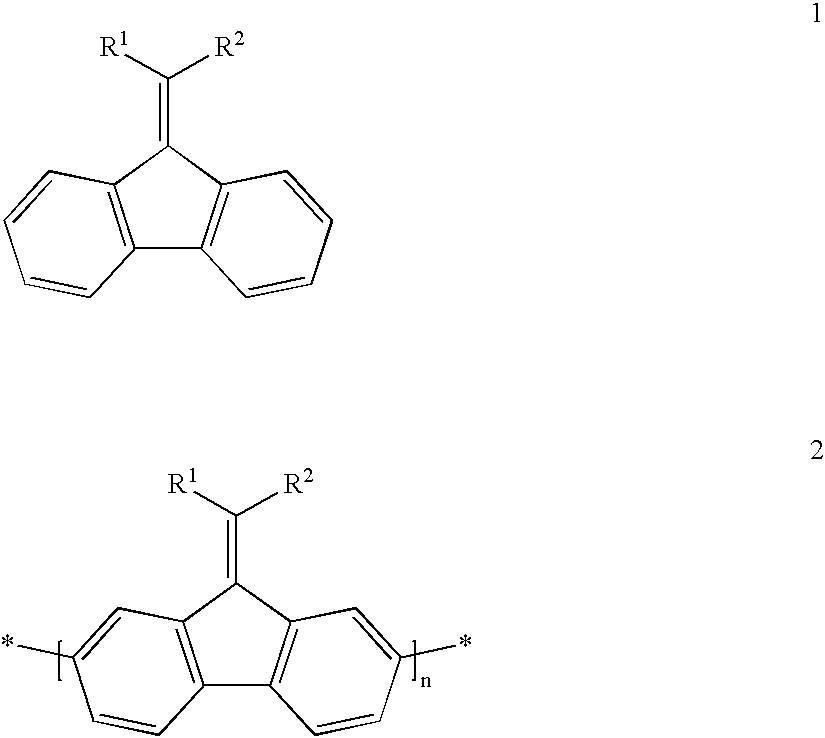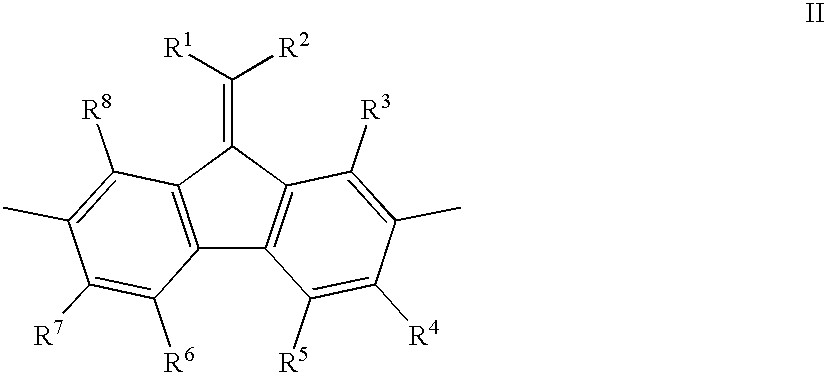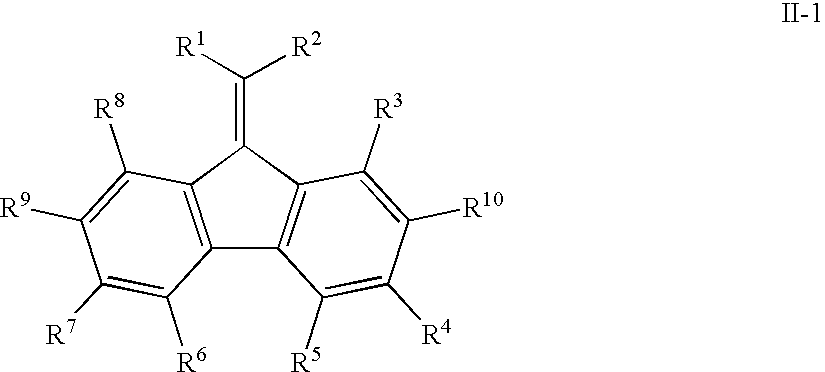Mono-, oligo-and polyalkylidenefluorenes and their use as charge transport materials
a charge transport material and polyalkylthiophene technology, applied in the direction of discharge tube/lamp details, natural mineral layered products, synthetic resin layered products, etc., can solve the problems of reduced device performance, low ionisation potential of poly(3-alkylthiophenes), and high processing cost of vacuum deposition
- Summary
- Abstract
- Description
- Claims
- Application Information
AI Technical Summary
Benefits of technology
Problems solved by technology
Method used
Image
Examples
example 1
2,7-Dibromofluorenone (1) was prepared as described below: ##STR14##
2,7-Dibromofluorene (20.00 g, 61.72 mmol), potassium permanganate (31.61 g, 200.0 mmol) and copper(II) sulphate pentahydrate (49.94 g, 200.0 mmol) were ground together to afford a fine powder. The powder was heated at 175-180.degree. C. for 6 h. After cooling to room temperature, tetrahydrofuran (1 L) was added and the mixture was sonicated for 30 minutes before being filtered through celite. The solvent was removed under reduced pressure to afford a crude product, which was triturated with hot methanol (300 mL) and filtered before being dried under reduced pressure to afford 2,7-dibromofluorenone (1) (17.94 g, 86%) as a yellow solid, purity 100% (GC): .sup.1 H and 13C NMR spectra as expected; M.sup.+ =338 (t).
2,7-Dibromo-9-dibromomethylenefluorene (2) was prepared as described below: ##STR15##
Triphenylphosphine (34.89 g, 133.0 mmol) was added to a solution of 2,7-dibromofluorenone (17.94 g, 53.08 mmol) in anhydrous...
example 2
2,7-Dibromo-9-(bis-pentylsulfanyl-methylene)fluorene (4) was prepared by a procedure as described in example 1 (63%): ##STR17##
.delta..sub.H (CDCl.sub.3, 300 MHz) 9.1 (2H, s), 7.50 (2H, d), 7.40 (2H, d), 3.05 (4H) 1.65 (4H, m), 1.5-1.3 (8H, m), 0.85 (6H, t); .delta..sub.c (CDCl.sub.3, 75 MHz) 145.4, 139.7, 137.5, 136.1, 130.28 (ArCH), 129.4 (ArCH), 121.0, 120.3 (ArCH), 36.3, 31.0, 29.8, 22.3, 14.0; M.sup.+ =540 (t).
example 3
2-Bromo-9-(bis-methylsulfanyl-methylene)fluorene (5) was prepared as described in example 2 using methyliodide as the alkylating agent. (76%). M.sup.+ =350 (d). .sup.1 H NMR displayed the expected signals. ##STR18##
PUM
| Property | Measurement | Unit |
|---|---|---|
| carrier mobilities | aaaaa | aaaaa |
| temperature | aaaaa | aaaaa |
| charge transport properties | aaaaa | aaaaa |
Abstract
Description
Claims
Application Information
 Login to View More
Login to View More - R&D
- Intellectual Property
- Life Sciences
- Materials
- Tech Scout
- Unparalleled Data Quality
- Higher Quality Content
- 60% Fewer Hallucinations
Browse by: Latest US Patents, China's latest patents, Technical Efficacy Thesaurus, Application Domain, Technology Topic, Popular Technical Reports.
© 2025 PatSnap. All rights reserved.Legal|Privacy policy|Modern Slavery Act Transparency Statement|Sitemap|About US| Contact US: help@patsnap.com



